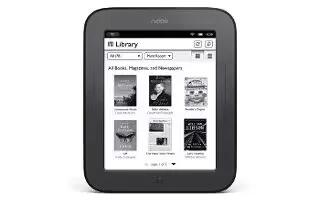For: Social Networking Functionality, Clean and Clear Reading Experience, Portability.
Against: Touchscreen less than ideal, 3G capability not available, Buggy software, Physical buttons are stiff
The usage of tablets and reader apps for smartphones have left a big impact on e-reader market, while the market for devoted readers continues to be dominated by Amazons Kindle. Barnes & Noble launched new black and white e-readers based around the same touch and display technologies. Nook has hit back with this latest Nook as the proof of its focus on the main thing: Reading.

The usage of tablets and reader apps for smartphones have left a big impact on e-reader market, while the market for devoted readers continues to be dominated by Amazons Kindle. Barnes & Noble launched new black and white e-readers based around the same touch and display technologies. Nook has hit back with this latest Nook as the proof of its focus on the main thing: Reading.
Hardware

The device is 0.47-inches about 11.9mm, its a bit thicker than the latest version of Kindle, but it has a concave back, with a gripping. The 6.5 by five inch (16.5 / 12.7 cm) reader is smaller than Kindle; the new foot print certainly brings a new found portability to the reader. The one button talk is exaggerated. This issue caused a debate online. While some people were playing Party Poker and others were searching for funny videos and photographs, those of us who are tech-savvy were hammering out the details; when we meet to pick up the Nook it used the qualifier essential to describe the one button situation. The button N below the screen, supplements the touch interaction, popping up a toolbar at the bottom of the screen. The non-essentials being the page forward and page backward raised lines on either side of the screen and power button on the rear.

It got 2GB of internal storage, and offers a micro SD card slot, and lets you expand them up to 32GB. The companys cloud storage, should keep you reading for a while. The battery life we have seen some online squabbling about Barnes & Noble and Amazons respective claims of two months precisely, it is safe to you about that battery bar on long trips. It got 800 MHz TIOMAP3 processor, zipper than Kindles 532 MHZ Freescale i.MX353, and page turns, start up, and PDF viewing all moved swiftly. The latest version of Nook is WiFi only, a fact that may drive some users into Amazons 3G capable arms.

The Pearl E Ink marked a major step up in contrast over first-generation readers. The device cant handle a comics or magazines like a Nook Color or iPad, but it does with high contrast and clarity for black and white text images. The page turn rate on the new Nook is quite swift, as well, beating out the third generation Kindle not by leaps and bounds, difference is certainly noticeable, helped along by the fact that the reader often only requires a full refresh every half-dozen pages or so. The update of Neonodes zForce infrared touch experience, offering a touchscreen reading interface that promises to blur the line between using an e-reader and an old timely book. The infrared technology is built into the bezel of the device, rather than the screen, so contrast not suffers. The zForce is responsive, advancing, or scrolling with a light touch. The size of the device allows for simple one handed without having rely on the bezels buttons navigating through menus, likely require two hands.
Software


The Nooks software experience is the home page, always a couple of taps away. The page shows what page you are on, three most recent downloads, and a list of books that your friends are taking about. The toolbars along the top offers up battery life, time, WiFi strength, the number of new messages to friends, and a book icon, brings you back to your current reading selection. The page is accessed by clicking the N button, pops up a tool bar that brings up the library, shopping, search, and settings. The Go To in the tool bar lets you to skip quickly and shows your current chapter. The text can be customizable, with seven sizes, six styles, and three line spacing and options. Clicking Publisher Defaults will clear all of that out. There is a Merriam-Webster dictionary built-in and the highlight feature is tough to master with the infrared touchscreen and attempting to share entire passages can be a maddening. You can share your quotes with your friends list through Facebook and Twitter. Messages are sent using the on-screen virtual keyboard, like highlighting feature, is not optimized for the devices touch screen. The built-in shop lets you to search for books magazines, and newspapers or browse based on lists and recommendations based on past purchases. If the book is bought, it is launched to your library and on the home page. You can drag them into the PCs in case of PDFs. Nooks limited PDF functionality is a bit of disappointment.
For:
Social Networking Functionality, Clean and Clear Reading Experience, Portability.
Against:
Touchscreen less than ideal, 3G capability not available, Buggy software, Physical buttons are stiff
Conclusion
The new Nook is adding more features and attempts to return to the simple reading experience missing from tablets like iPad and Nook Color. All new features focuses on goal of reading, the social functions are about reading and reading alone. The price of $139 the Nook fits well. The reader is buggier than what we hoped; the touch technology is also not up to the standards we expected got quite freezing put overall stability a question. Finally what we can say is its a great device for just plain reading.
